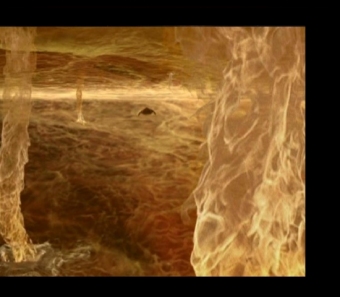
In Star Trek, a plasma storm is a type of spatial
disturbance that involves energetic particles in a state called plasma.
Plasma storms are commonly found in places such as the Badlands. (DS9:
"The Maquis, Part I", "For the Cause", "Blaze of Glory"; VOY:
"Caretaker"). The Badlands in particular had an energetic plasma field
which was quite extensive and made starship navigation very difficult.
Sensors are also limited by plasma fields. (DS9: "Heart of Stone", "For
the Cause", "For the Uniform")
The Denorios belt was a charged plasma field. (DS9:
"Emissary"). In 2373, Benjamin Sisko and Michael Eddington used the
impulse exhaust of a Danube-class runabout to detonate a plasma field
aft of them, hoping to damage or destroy several pursuing Jem'Hadar
attack ships. The plan worked and the detonation of the plasma field
knocked the enemy ships off course. (DS9: "Blaze of Glory"). A
Federation troop convoy used the plasma fields of the Badlands to hide
their movements from the Dominion in 2374. (DS9: "Waltz"). While trying
to figure out what had happened to a group of officers who encountered
a Type 2 plasma storm on their way back to Deep Space 9, Doctor Julian
Bashir did a search in the medical files about such a phenomenon and
found 5,021 entries. (DS9: "Things Past"). Professor Jennifer Sisko was
working on a transpectral sensor array, a device that might be able to
penetrate the plasma storms in an effort to find hidden Terran
Rebellion bases in 2371 in the mirror universe. (DS9: "Through the
Looking Glass").
Plasma is a partially ionized gas, in which a certain
proportion of electrons are free rather than being bound to an atom or
molecule. Plasma is by far the most common phase of matter in the
universe, both by mass and by volume. All the stars are made of plasma,
and even the space between the stars is filled with a plasma. Large
concentrations of plasma can form plasma clouds. Little is known with
certainty of what actually occurs in real clouds that have been
discovered by scientists. However, recent observations indicate that
the conditions can get stormy in these enormous clouds of rolling
plasma as they may be drawing their energy from black holes located
inside them.
The large plasma cloud detected by the team of
astronomers led Los Alamos scientist Philipp Kronberg in April 2007
overlap with a loose grouping of seven radio-bright galaxies. Such
galaxies are thought to contain extremely massive black holes at
their centres, and the cloud's discoverers suspect it is these black
holes that power the cloud. Such black holes often have powerful jets
of magnetised material streaming from them. The jets may stir up
intergalactic gas, transforming it into a
high-energy plasma.
Energetic particles escaping from such clouds could
potentially make their way to Earth as mysterious "ultra high energy
cosmic rays". UHECRs, as they are known, are so powerful that
astronomers do not understand what could accelerate them to such high
energies.
Another possible origin of UHECRs is the collapse of
massive stars to form black holes. These violent events give off bursts
of gamma rays and, some astronomers speculate, ultra-high energy
particles as well.
|
